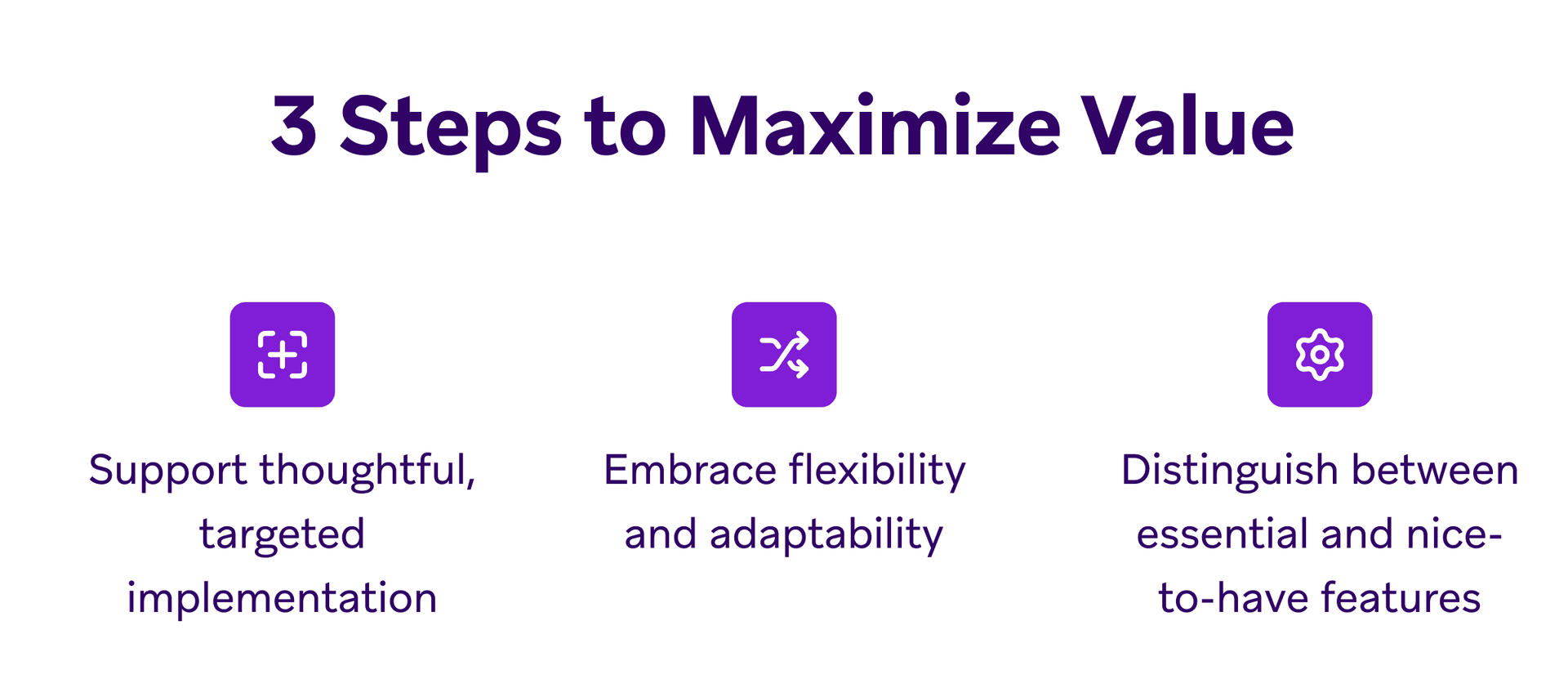Build vs. Buy: How Technical Teams Can Ensure Success with Third-Party Tools
Published on October 25, 2024/Last edited on October 25, 2024/8 min read

Tom Howard
Staff Engineer, MiroWhen a company needs a new technical solution, teams face a common dilemma: Build or buy? Both approaches have their advantages—building products in-house offers the opportunity for full customization and alignment with business needs, while buying third-party software provides access to proven, scalable solutions more quickly. The choice to build or buy often depends on the company’s priorities, resources, and time constraints.
If you were to decide to build, the first step would be lining up stakeholders to figure how to prioritize the right resources. If you decide to buy, ensuring stakeholder alignment is just as important…and the real work begins after purchase. Success doesn’t just come from acquiring the tool—it comes from how well it's integrated into the wider ecosystem and supported across your organization.
I’m Tom Howard, Staff Engineer at Miro, and I’ve worked at multiple engineering-led companies, seeing firsthand how crucial it is for technical stakeholders to fully support the decision to buy—in the same spirit as if they owned the technical development of a product or feature. In the article below, I’ll share the drawbacks of leading with a build-only mindset and how technical teams can use third-party tools to set them up for success.
The Dangers of a Build-Only Mindset
On the surface, building products in-house may feel like the best way to get exactly what you need. But when a tool or feature isn’t tied to your company’s core business, it can quickly lead to hidden (and not-so-hidden) costs.
Here’s where teams often run into trouble:
- Believing that building a solution is a “one time” investment, when the changing needs of the business make this a long term commitment the team and business need to accept.
- Time spent developing internal tools takes focus away from impactful initiatives that are core to the business.
- Custom-built solutions may not scale easily to the changing needs of the business; third party tooling is often built to be more generic and can potentially adapt more easily to new requirements..
- Maintaining and troubleshooting internal tools drains resources over time, slowing down your ability to innovate.
- Internal teams can struggle to keep pace with the rapid innovations and industry standards that external vendors continuously deliver. Such as out-of-the-box integrations with other third party systems.
By choosing a trusted third-party tool, you can keep your team focused on what matters—innovating in areas that directly drive your business—while benefiting from the expertise and technology provided by specialists.
Understand a Tool’s Strengths and Limitations
Still, buying software isn’t a magic fix. One of the most common mistakes companies make after choosing to buy is failing to fully understand a tool’s capabilities and how to leverage those to meet the needs of the company. Even with a third-party solution, success hinges on how well you grasp what the tool can—and can’t—do.
That’s why it’s important to invest time upfront to understand capabilities, limitations and integrations. Dive into the documentation, explore all the features, and connect with the vendor’s support team. Take the time to understand how the tool is designed to be used, which may mean realigning your internal workflows with that of the tool. Working against the tool can lead to excessive friction and negative outcomes on all sides, effectively forcing a square pin into a round hole.
Getting the Most Value From Your Third-Party Tool Investments
Before you move ahead on the decision to buy, it’s important to start the conversations between key stakeholders. One key stakeholder is Engineering, especially if there is a need to build integrations around the tool with the wider ecosystem. After all, nothing good will come of purchasing a third-party tool only to find that Engineering doesn’t have the bandwidth (or the willingness) to implement it.
One of the best ways to do that is to involve all relevant stakeholders in the decision process, allowing them to air concerns and talk through issues as they arise, rather than surprising them with the news of a purchase after it’s done. Involving Engineering early means they can be part of the evaluation of potential vendors. Assessing technical aspects such as API availability and quality along with scalability and performance of the tool. Also important is evaluating compatibility of libraries with systems that the tool needs to integrate with. This can be critical in smoothly integrating into your other systems, or to building extensions on top of the tool to provide business specific features. Purchasing a tool and then discovering that an SDK is not available in a required programming language, or is incompatible with other libraries in your environment can be costly.
One good approach here is to organize a point of contact (PoC) with the vendor. Getting access for a period of time to allow you to “kick the tires” on the product. However you should enter a PoC with a clear vision of what success looks like. For example, coming to the PoC with several clearly defined use cases which represent the problems the tool is expected to solve. Then running those against the tool to understand how the tool performs in fulfilling those use cases. Where possible, leverage the vendor to support you, so that they can help guide you to solutions.
Once your team decides to buy, the next step is making that investment pay off. It’s not enough to bring a tool into the fold—how you implement and support it will ultimately determine its success. Technical teams play a major role in making sure the new tool fits into your business and delivers the value you anticipate at the time of purchase.

Support Thoughtful, Targeted Implementation
Technical teams carry the bulk of the responsibility when integrating a third-party tool. My advice is for these teams to treat implementation as a project. By testing the tool in different scenarios to catch potential issues before they disrupt operations, it’s possible to address any challenges early. That way, you can ensure teams are set up for long-term success, not stuck trying to understand what the tool can and can't do further down the road.
It's also important to avoid undocumented shortcuts or 'hacks' within the tool which can lead to instability and extra maintenance down the road. Thinking again about working with the tool, and not against it.
Embrace Flexibility and Adaptability
As a technical stakeholder, I’ve seen firsthand that no software can do everything. While there are times when a tool’s limitations are too significant, and you need to find a new solution, more often, you just need to adjust how you work to better fit what the tool can do.
Instead of rushing to replace the software that isn’t serving you, it’s worth asking: Can we tweak our processes to make the tool work for us? Small changes in how you use the tool can often unlock its full potential without the hassle and expense of switching to something else. Sometimes, it’s not about finding a different tool—it’s about making the one you have work smarter for your team.
It’s also easy to believe that the challenges you are facing are unique to your business. However, these challenges can actually be more common across other organizations. A third party working with multiple organizations has potentially identified, and resolved these issues within their product.
Distinguish Between Essential and Nice-to-Have Features
When teams are choosing software, it can be tempting to create long wishlists of features. But only certain features are crucial for success, and chasing a tool that ticks every box can lead to disappointment in the chosen tool, or an endless search. Also, some features in tools can be add ons which incur additional costs. Prematurely purchasing features you do not later use can be costly or lead to a motivation to use the feature to justify the expense, even if this is not beneficial to the business.
It’s important to have clear conversations with stakeholders and prioritize high-level goals both during evaluation and as you approach implementation. Focus on the set of features that truly drive impact, rather than trying to get everything on your list. By aligning on the essentials, you will avoid overcomplicating your tech stack and ensure that the tools you select deliver real value.
Conclusion
Making the decision to buy a third-party tool is just the beginning. As we've discussed, success comes from how well you integrate, support, and adapt the tool to fit your business. While building a solution in-house may seem appealing, buying often provides a quicker path to value, allowing you to leverage best-in-class expertise and resources. No tool will ever be perfect, but with the right approach, you can unlock the full potential of the software you buy and deliver lasting value. This sets the stage for exploring how to effectively implement and maximize your investment in these tools.
For more insights into the build vs. buy dilemma, I recommend reading Jamie Doheny’s article A Technology Leader's Perspective on Build vs. Buy, which dives deeper into how to make the right call for your business.
Related Tags
Be Absolutely Engaging.™
Sign up for regular updates from Braze.
Related Content
View the Blog
The new inbox reality: How iOS changes are reshaping email marketing

Aparna Prasad

Experience optimization: Turning data insights into better journeys

Team Braze

December 2025 Bonfire Marketer of the Month: Jagex’s Emma Oliver
